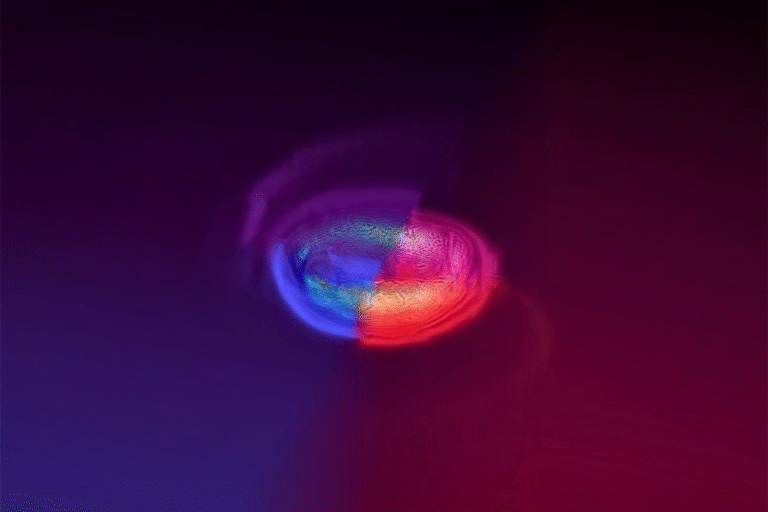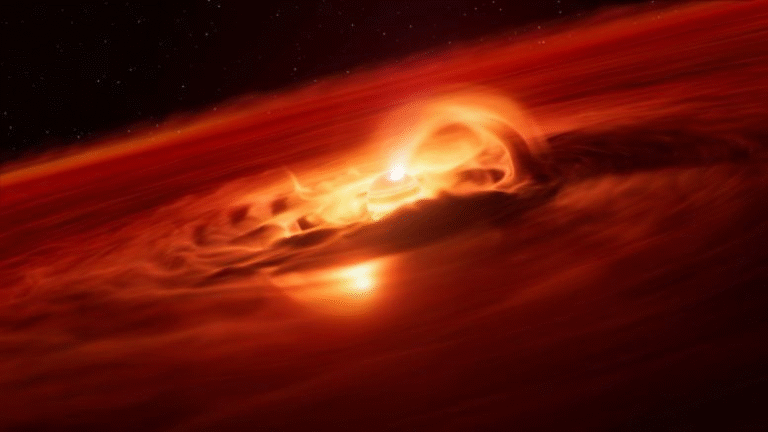James Webb Space Telescope Unveils Astonishing Details of the Red Spider Nebula

The James Webb Space Telescope (JWST) has once again proven its power by revealing breathtaking new details of the Red Spider Nebula, also known as NGC 6537. Located in the constellation Sagittarius, near the dense heart of the Milky Way, this nebula is a spectacular example of a planetary nebula — the final, short-lived phase of a dying star similar to our own Sun.
Using its Near-Infrared Camera (NIRCam), Webb has peered deep into this cosmic “spider,” exposing structures and features that previous telescopes, such as the Hubble Space Telescope, could not detect. These fresh observations provide astronomers with crucial insights into how stars die, shed their outer layers, and sculpt some of the universe’s most beautiful celestial shapes.
The Red Spider’s Fiery Anatomy
At the heart of NGC 6537 lies a blisteringly hot central star, glowing around 160,000 K, surrounded by a veil of hot dust. This dust was invisible to optical telescopes but now appears prominently in Webb’s near-infrared view. The central star had previously appeared faint and blue in Hubble images, but with JWST’s infrared sensitivity, it shines bright red, wrapped in a halo of material that is likely part of a dusty disk orbiting the star.
The nebula’s distinctive shape features a narrow waist and two large lobes, or “legs,” stretching outward like the limbs of a spider. These massive structures are made of molecular hydrogen (H₂) gas and are seen glowing in Webb’s imagery as brilliant blue loops. Each lobe extends roughly three light-years from the center, forming closed bubble-like shells that have been expanding for thousands of years.
This stunning bipolar, or hourglass, shape is the result of powerful outflows of gas that erupted from the star as it reached the end of its life. These outflows likely collided with material previously expelled by the star, creating the rippling texture visible in Webb’s detailed images.
A Jet That Carves the Cosmic Web
One of the most striking findings in Webb’s observation is a purple S-shaped feature winding through the center of the nebula. This structure traces ionized iron (Fe II) emission and marks the path of a high-speed jet shooting out from the star’s vicinity.
As this jet plows into slower-moving gas ejected earlier in the star’s life, it sculpts the intricate, web-like structure of the nebula. The interaction between these fast and slow flows creates turbulence and shock waves that glow in infrared light, revealing the energetic processes shaping the Red Spider Nebula.
The presence of such jets and lobes implies a complex internal dynamic — one that astronomers believe is not caused by a single dying star alone.
The Hidden Companion Hypothesis
Though only one central star is visible, evidence suggests that a hidden companion star may be orbiting nearby. This companion could explain the nebula’s symmetrical hourglass shape and narrow waist. When two stars orbit closely, gravitational interactions can channel material into bipolar outflows and dense equatorial rings, giving rise to the sculpted shapes seen in many planetary nebulae.
In NGC 6537, the suspected companion may have played a key role in forming the dense equatorial torus — a donut-shaped structure of gas and dust encircling the nebula’s center. Observations from the Atacama Large Millimeter/submillimeter Array (ALMA) revealed that this torus expands at about 10 km/s and has a radius of roughly 0.13 parsecs (or about 0.4 light-years).
If the binary system theory is correct, the interaction between the dying star and its companion might have triggered the dramatic mass loss that gave the nebula its unique form.
The Fleeting Beauty of Planetary Nebulae
Planetary nebulae like the Red Spider represent one of the final, most beautiful chapters in a star’s life. When a sun-like star runs out of hydrogen in its core, it swells into a red giant and begins to shed its outer layers into space. Eventually, the remaining white-hot core emits ultraviolet light that ionizes the ejected gas, causing it to glow — forming the nebula.
However, this phase is short-lived on a cosmic timescale, lasting only tens of thousands of years. Over time, the nebular gas disperses into interstellar space, enriching the surrounding regions with carbon, oxygen, and nitrogen — essential ingredients for new stars and planets.
The Red Spider Nebula is thus a preview of what may happen to our own Sun billions of years from now. Though the scales and shapes will differ, the physical process — the shedding of outer layers and creation of a glowing shell — will be similar.
A Glimpse into Stellar Death and Rebirth
The Red Spider Nebula’s story doesn’t end with death. The material ejected from the dying star will eventually mix with the interstellar medium (ISM) — the vast sea of gas and dust between stars. This enriched material becomes the raw ingredient for new generations of stars and planets.
In this way, planetary nebulae are both endings and beginnings. The atoms in our bodies, our air, and our oceans were likely forged in stars that lived and died billions of years ago. The Red Spider Nebula offers a vivid reminder that cosmic death fuels cosmic rebirth.
Why Webb’s View Changes Everything
Before JWST, even high-resolution Hubble images couldn’t penetrate the dense dust near the nebula’s core. Now, with infrared light, Webb allows astronomers to see through the dust and map structures that were once completely hidden.
This capability is transforming our understanding of planetary nebulae, showing that they are not simple spherical clouds but highly structured, dynamic, and evolving systems influenced by binary interactions, magnetic fields, and asymmetric winds.
In addition to Webb’s data, Chandra X-ray Observatory observations found no X-ray emission from either the central star or the nebula itself, suggesting that the powerful outflows seen in infrared do not currently produce high-energy radiation detectable in X-rays. This further helps refine models of how such outflows evolve over time.
What Makes NGC 6537 Unique
Compared to other planetary nebulae, such as the Butterfly Nebula (NGC 6302) or the Cat’s Eye Nebula (NGC 6543), the Red Spider stands out for its exceptionally hot central star, massive closed lobes, and jet-driven S-shaped structure.
The newly discovered bubble-like lobes are estimated to have been inflated by outflows moving at several hundred kilometers per second over thousands of years. The surrounding dust disk, glowing in near-infrared light, gives the nebula its signature reddish hue, with blue hues tracing the molecular hydrogen emissions from the lobes.
Together, these features make NGC 6537 a remarkable laboratory for studying stellar mass loss, binary interactions, and nebular dynamics in exquisite detail.
The Broader Scientific Value
Beyond its visual beauty, the Red Spider Nebula helps scientists better understand the future of solar-type stars and the chemical enrichment of galaxies. Studying objects like this provides clues to how elements heavier than hydrogen and helium are recycled into space, setting the stage for future planetary systems.
The discovery also reinforces the idea that companions play a vital role in shaping planetary nebulae — a growing consensus among astronomers studying JWST data from other bipolar nebulae.
With JWST’s continuing mission, astronomers expect to uncover more such systems, each revealing different aspects of how stars die and transform their surroundings.





